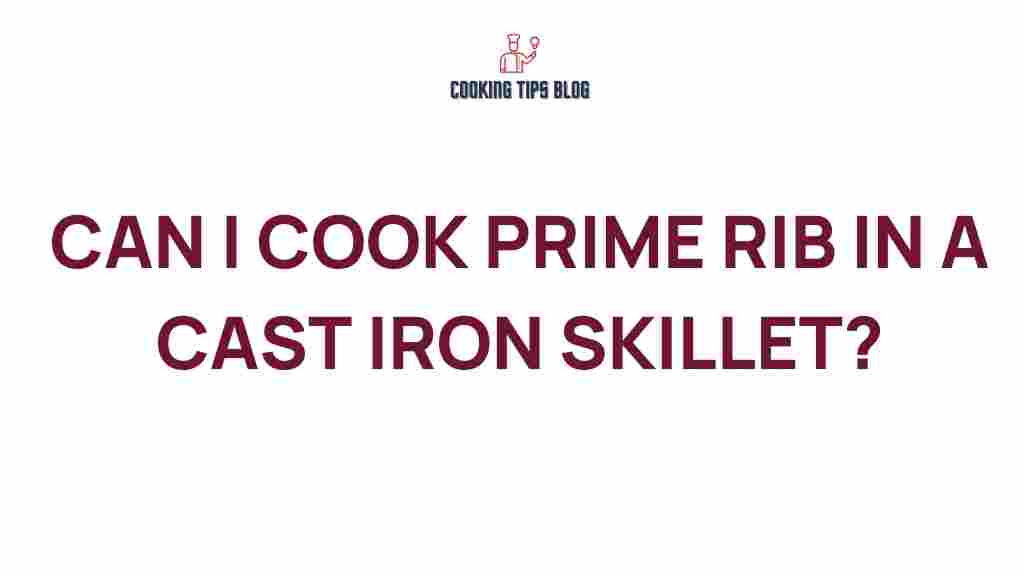Unlocking the Secrets: Can You Cook Prime Rib in a Cast Iron Skillet?
When it comes to cooking a perfect prime rib, the choice of cookware can make all the difference. Many home cooks may wonder: can you cook prime rib in a cast iron skillet? The answer is a resounding yes! Cast iron skillets are not only versatile but also excellent for achieving that beautiful sear and flavor that prime rib is known for. In this article, we will delve into the secrets of cooking prime rib in a cast iron skillet, providing you with a step-by-step guide, troubleshooting tips, and everything else you need to know.
Why Choose Cast Iron for Prime Rib?
Before we dive into the cooking process, let’s explore why a cast iron skillet is a fantastic choice for preparing prime rib:
- Heat Retention: Cast iron skillets retain heat exceptionally well, allowing for even cooking.
- Versatility: You can use them on the stovetop and finish cooking in the oven.
- Flavor Enhancement: The seasoning on cast iron skillets can add a unique flavor to your prime rib.
- Durability: With proper care, cast iron skillets can last a lifetime.
Preparing Your Prime Rib
Now that you understand the benefits of using a cast iron skillet, let’s get started on preparing your prime rib for the ultimate cooking experience.
Ingredients You Will Need
To cook a delicious prime rib, gather the following ingredients:
- 1 (4-6 pound) prime rib roast
- Salt (preferably kosher salt)
- Black pepper
- Garlic powder
- Onion powder
- Fresh herbs (such as rosemary and thyme)
- Olive oil or butter
Step-by-Step Cooking Instructions
Follow these steps to cook your prime rib to perfection in a cast iron skillet:
Step 1: Preparing the Meat
Start by removing your prime rib from the refrigerator and letting it come to room temperature for about 1-2 hours. This ensures even cooking.
Step 2: Seasoning
Generously season the prime rib with salt, black pepper, garlic powder, and onion powder. You can also rub the meat with olive oil or butter for added flavor. Make sure to coat all sides evenly, and consider adding fresh herbs for an aromatic touch.
Step 3: Preheating the Skillet
Place your cast iron skillet on the stovetop and preheat it over medium-high heat. You want the skillet to be hot enough to create a nice sear on the meat.
Step 4: Searing the Prime Rib
Once the skillet is hot, place the prime rib in the skillet, fat side down. Sear for about 4-5 minutes until a crust forms. Flip the meat and sear the other side for an additional 4-5 minutes.
Step 5: Transferring to the Oven
After searing, transfer the skillet to a preheated oven set to 325°F (163°C). Roast the prime rib until it reaches your desired level of doneness:
- Rare: 120°F (49°C)
- Medium rare: 130°F (54°C)
- Medium: 140°F (60°C)
- Medium well: 150°F (65°C)
- Well done: 160°F (71°C)
Use a meat thermometer for accurate readings.
Step 6: Resting the Meat
Once your prime rib reaches the desired temperature, remove it from the oven and let it rest for at least 20-30 minutes. This allows the juices to redistribute, resulting in a tender and juicy roast.
Serving Suggestions
After resting, slice your prime rib against the grain and serve it with your choice of sides. Popular options include:
- Garlic mashed potatoes
- Roasted vegetables
- Yorkshire pudding
- Fresh salad
Troubleshooting Tips for Cooking Prime Rib in a Cast Iron Skillet
Even the most experienced cooks can face challenges. Here are some common issues and solutions when cooking prime rib in a cast iron skillet:
Issue 1: Uneven Cooking
If your prime rib is cooking unevenly, ensure that your skillet is preheated adequately before placing the meat inside. Additionally, consider rotating the skillet halfway through the cooking process.
Issue 2: Too Much Smoke
If you notice excessive smoke, your skillet may be too hot. Reduce the heat slightly or remove the skillet from the burner for a moment to cool down.
Issue 3: Dry Meat
To avoid dry prime rib, ensure you do not overcook it. Use a meat thermometer to keep track of the temperature, and always allow the meat to rest after cooking.
Issue 4: Lack of Flavor
If your prime rib tastes bland, it may be due to insufficient seasoning. Don’t be shy with salt and spices! Consider marinating the meat overnight for an extra flavor boost.
Conclusion
Cooking prime rib in a cast iron skillet is not only possible but also highly rewarding. With its excellent heat retention and versatility, a cast iron skillet can help you achieve a perfectly seared and flavorful prime rib that will impress your family and friends. By following the steps outlined in this guide and being mindful of common cooking issues, you can unlock the secrets to creating the ultimate prime rib dish.
For more tips on cooking and other delicious recipes, check out our cooking blog. If you’re looking for high-quality cast iron skillets, visit this site for some great options!
This article is in the category Recipes and created by Cookingtipsblog Team
